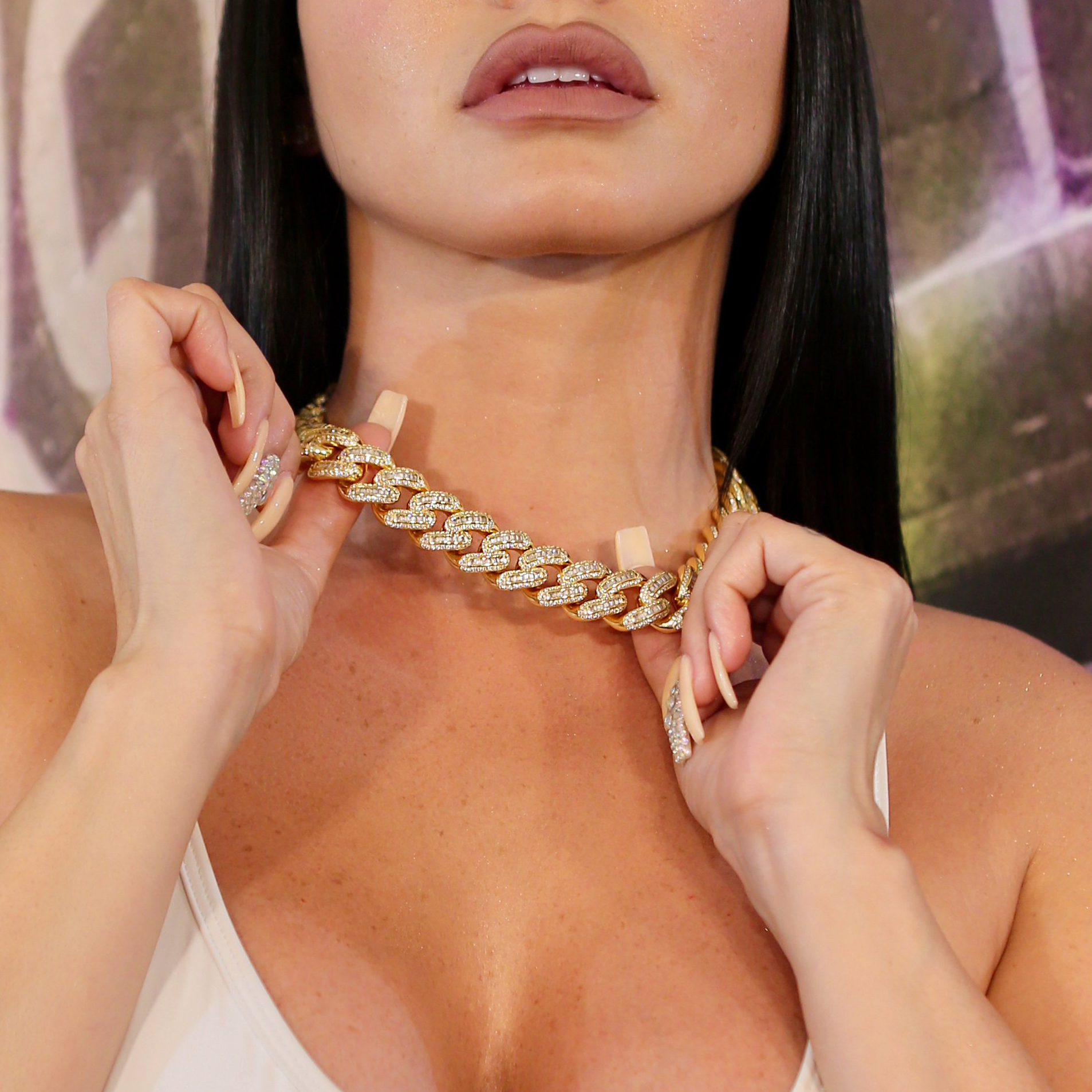What makes gold such a great material to use when crafting jewelry, is that gold is offered in a variety of materials. These materials will differ in purity, color, and durability. 14K gold is one of the most common choices—but is it actually good quality? Here's what you need to know, and why 18K gold is the better option.
What Is 14K Gold?
14K gold contains 58.5% pure gold mixed with 41.5% other metals (typically copper, silver, nickel, or zinc). The "14K" marking means 14 parts gold out of 24 total parts—hence the karat measurement.
The Composition Breakdown
- Gold content: 58.5% (just over half)
- Alloy metals: 41.5% (copper, silver, nickel, zinc)
- Purpose of alloys: Add hardness and durability to the softer pure gold
Is 14K Gold Good Quality?
The short answer: It's acceptable, but not premium. Here's the honest breakdown:
What 14K Gold Does Well
- Durability: Harder than 18K gold due to higher alloy content—resists scratches and dents better
- Affordability: Less gold content means lower price point than 18K
- Availability: Most common karat in the U.S. market—easy to find
- Daily wear: Can handle rough use without excessive wear
Where 14K Gold Falls Short
- Pale color: Noticeably lighter and less rich than 18K—lacks that luxe "gold" glow
- Lower value: Less gold content = lower intrinsic and resale value
- Compromised prestige: Not the professional standard for high-end jewelry
- Potential skin reactions: Higher alloy content (especially nickel) can cause irritation
- Less impressive on camera: The lighter tone doesn't photograph as richly as 18K
14K Gold vs 18K Gold: The Real Comparison
Gold Content
- 14K: 58.5% gold (less than two-thirds)
- 18K: 75% gold (three-quarters)
- Winner: 18K—significantly more actual gold for better value and prestige
Color Richness
- 14K: Lighter, paler yellow—acceptable but not impressive
- 18K: Deep, warm, luxurious gold tone—the color everyone wants
- Winner: 18K—richer color that photographs beautifully and looks premium
Durability for Jewelry
- 14K: Harder and more scratch-resistant—but can be brittle for intricate work
- 18K: Slightly softer, but perfect for chains, tennis settings, and Cuban links—holds shape while maintaining flexibility
- Winner: 18K—better balance for jewelry that needs both durability and workability
Value Retention
- 14K: Moderate resale value—better than 10K but still compromised
- 18K: High gold content = strong value retention and prestige
- Winner: 18K—holds value better over time
Skin Comfort
- 14K: Higher alloy content can cause reactions, especially with nickel
- 18K: More gold, fewer base metals = comfortable for most skin types
- Winner: 18K—gentler on sensitive skin
Professional Standard
- 14K: Common in mass-market jewelry—the "safe" middle choice
- 18K: The standard for luxury jewelers, designer pieces, and heirloom jewelry worldwide
- Winner: 18K—what professionals use when quality matters
Why 18K Gold Is Better Than 14K
1. Richer, More Luxurious Color
18K delivers that deep, warm gold tone that screams premium. 14K looks acceptable, but it's noticeably paler—especially in photos and under natural light. If you want jewelry that actually looks expensive, 18K is the only choice.
2. Higher Intrinsic Value
With 75% gold content versus 58.5%, 18K has significantly more precious metal. This means better resale value, stronger investment, and real prestige. You're not just buying jewelry—you're buying actual gold.
3. Better for Stone Settings
18K's slight softness is actually an advantage for prong settings. It grips CZ, moissanite, and diamonds more securely than harder 14K, which can be brittle and prone to prong breakage. For tennis chains and iced pieces, 18K is superior.
4. Enables Premium Finishes
18K allows for richer white gold and rose gold variations that 14K can't match. The higher gold content creates more consistent, luxurious tones across all finishes.
5. The Professional Choice
High-end jewelers worldwide use 18K as their standard. It's what you'll find in luxury boutiques, designer collections, and heirloom pieces. There's a reason: it's simply better quality.
When Does 14K Make Sense?
To be fair, there are limited scenarios where 14K is acceptable:
- Extreme budget constraints: If you're buying solid gold and need to save money
- Heavy manual labor: If you work with your hands constantly and need maximum scratch resistance
- You don't care about color richness: If the pale tone doesn't bother you
But for anyone who wants jewelry that looks and feels premium, 18K is worth the upgrade.
Why BLNG Uses Heavy 18K Plating (Not 14K)
At BLNG, we refuse to compromise on quality. That's why we use heavy 18K plating—not 14K or 10K. Here's what that means for you:
Rich, Luxurious Color
Our heavy 18K plating delivers that deep, warm gold tone that photographs perfectly and looks expensive in any light. 14K plating would give you a paler, less impressive finish.
Up to 10x Thicker Plating
We don't just use 18K—we use heavy 18K plating that's up to 10x thicker than typical boutique pieces. This means longer-lasting color and shine that resists daily wear.
Premium Over Premium Metals
Our 18K plating goes over stainless steel and sterling silver cores—not cheap base metals. This combination gives you the 18K look with everyday durability.
Professional Craftsmanship
Every BLNG piece is crafted by professional jewelers who work with 18K because it's the quality standard. Even color, smooth finishing, and secure hardware across every piece.
How to Style 18K Gold Jewelry
White Gold (18K)
Crisp, modern, frosty—pairs with steel watches, streetwear, and minimalist fits.
- 3mm Tennis Chain (White Gold)
- 4mm Tennis Chain (White Gold)
- 12mm Iced Out Cuban Link Chain (White Gold)
Yellow Gold (18K)
Rich, warm, classic—the "gold" everyone recognizes. Pops with black/white fits and neutrals.
Rose Gold (18K)
Soft, romantic, quietly luxe—flatters most skin tones.
Width & Length Guide
- Widths: 3–4mm for clean daily looks; 12mm for bold statements
- Lengths: 50 cm (20") is the universal sweet spot; 55 cm (22") adds drop; 60 cm (24") sits relaxed over hoodies
Care for 18K-Plated Jewelry
- Wipe with a soft cloth after wear
- Apply fragrance before jewelry, not after
- Avoid pools, hot tubs, and harsh chemicals
- Store separately to prevent micro-scratches
- Quick clean: lukewarm water + mild soap → rinse → dry fully
Shop BLNG's Heavy 18K Plated Collection
- Tennis Chains — Clean sparkle with 18K richness
- Cuban Link Chains — Bold texture in premium 18K finish
- Cuban Link Bracelets — Wrist symmetry with 18K glow
- Pendants — Meaningful symbols in 18K finishes
The Bottom Line: 14K vs 18K
14K gold is acceptable—it's durable, affordable, and widely available. But it's a compromise. The pale color, lower gold content, and lack of prestige mean you're settling for "good enough" instead of "actually premium."
18K gold is better in every way that matters for jewelry: richer color, higher value, better for stone settings, more comfortable on skin, and the professional standard worldwide. It's the difference between jewelry that looks nice and jewelry that looks luxurious.
At BLNG, we use heavy 18K plating (up to 10x thicker than typical pieces) because we refuse to compromise. You get the 18K look—deep, warm, and premium—at accessible pricing, backed by professional craftsmanship and secure hardware.
If you're building a stack that actually looks expensive and holds its value, 18K is the only choice that makes sense.






Share:
What Are the Different Types of Gold Chain Links?
What is 24K Gold? Is 24K Gold The Best?